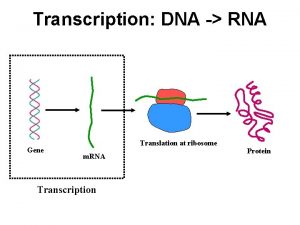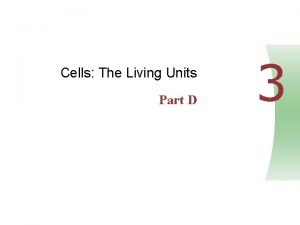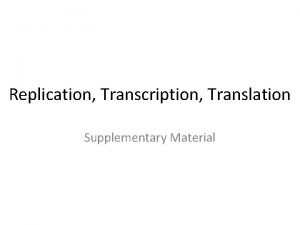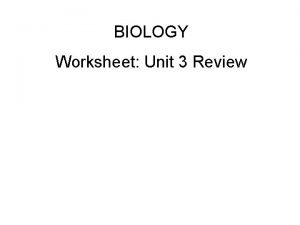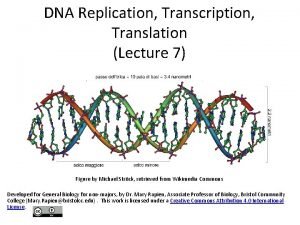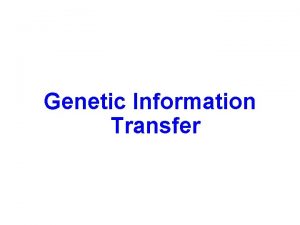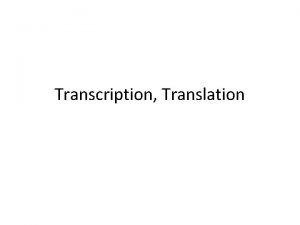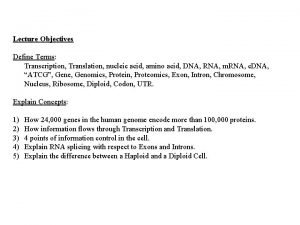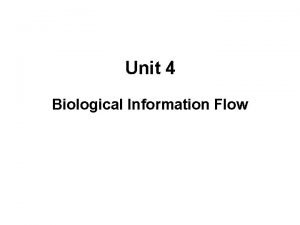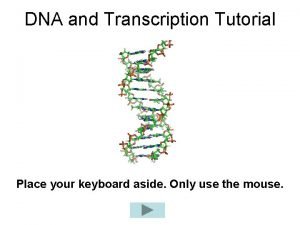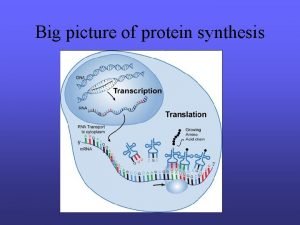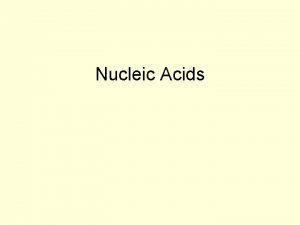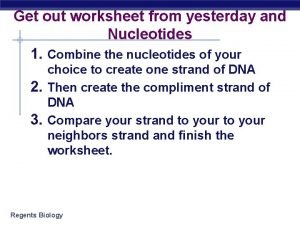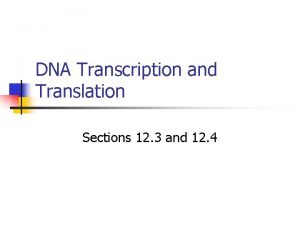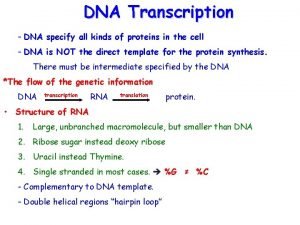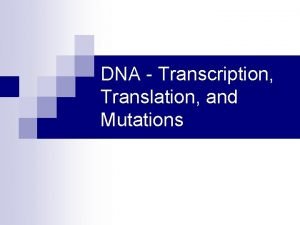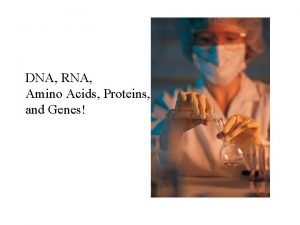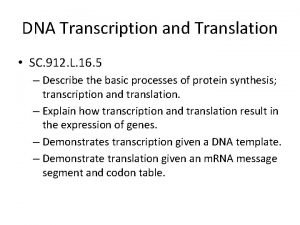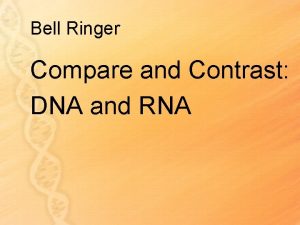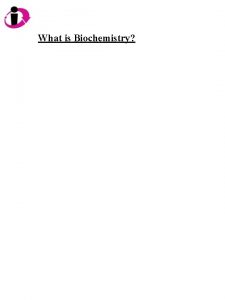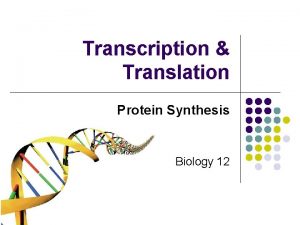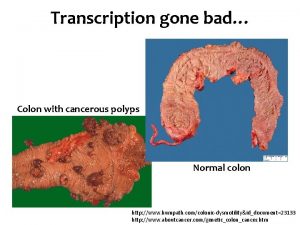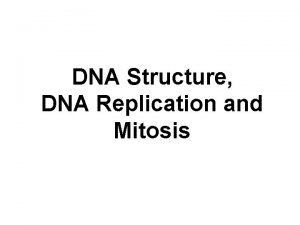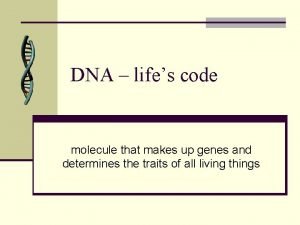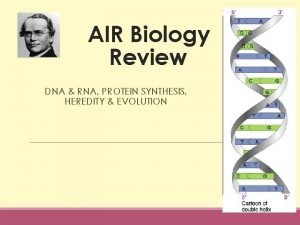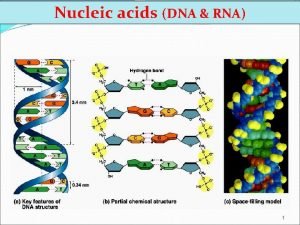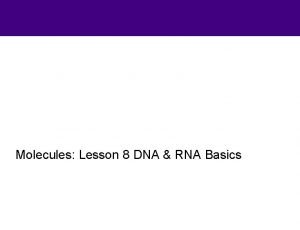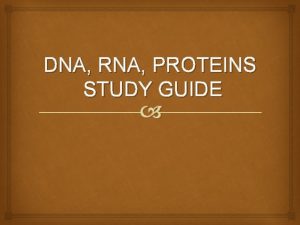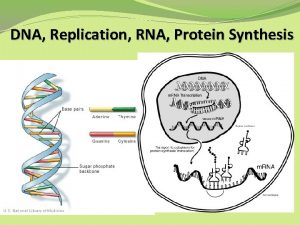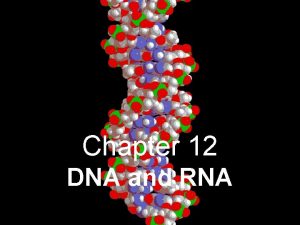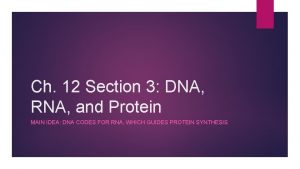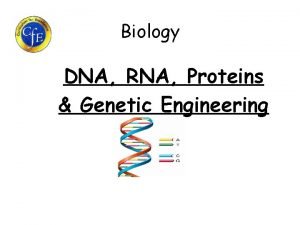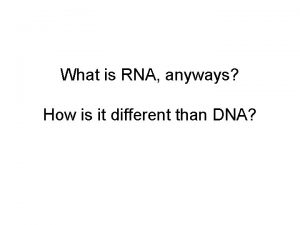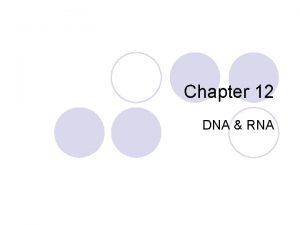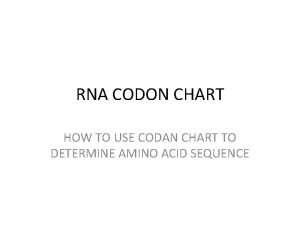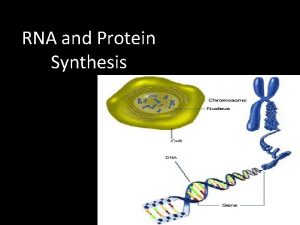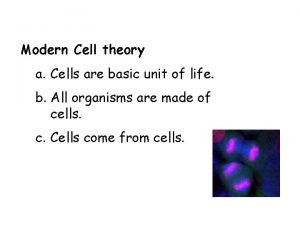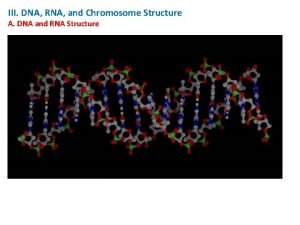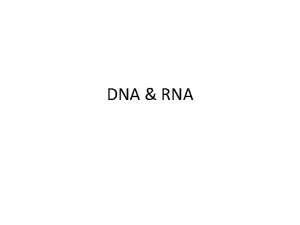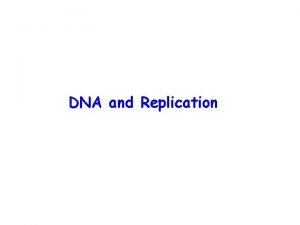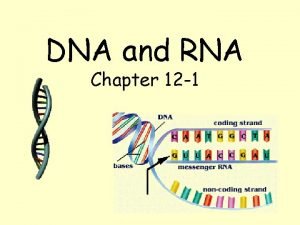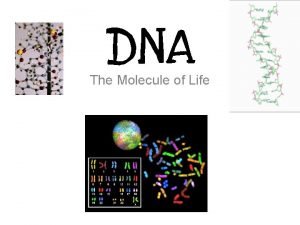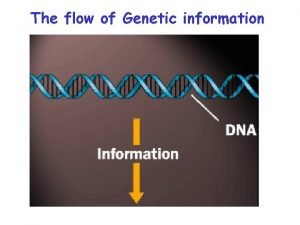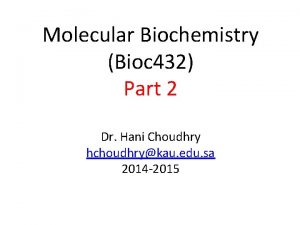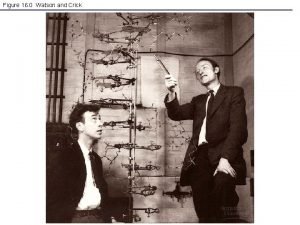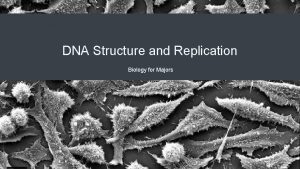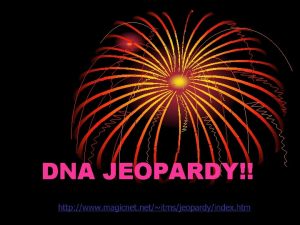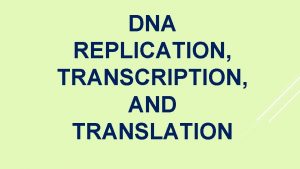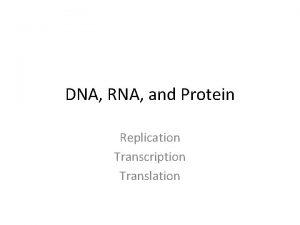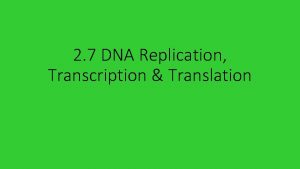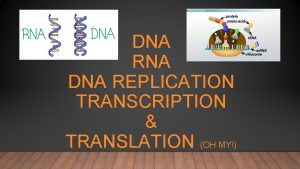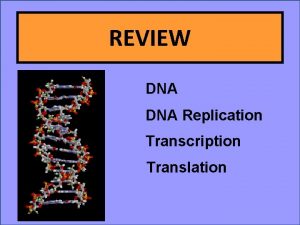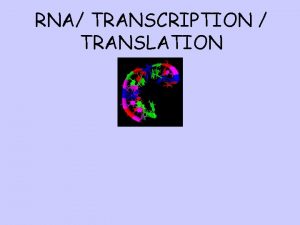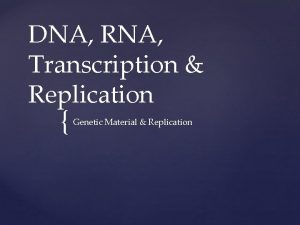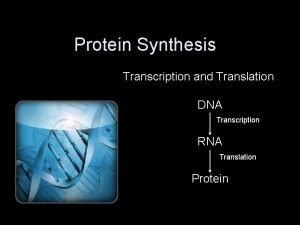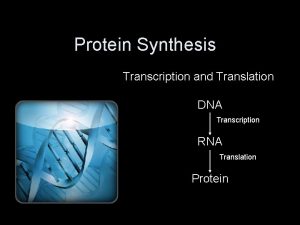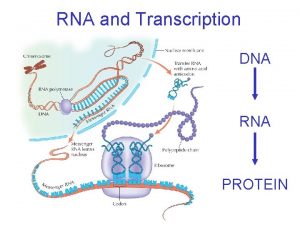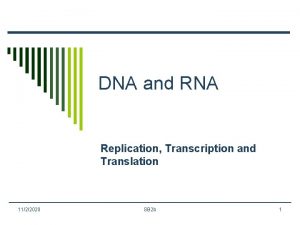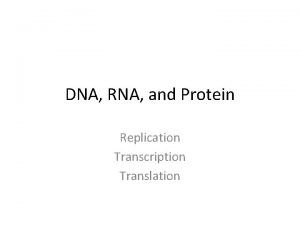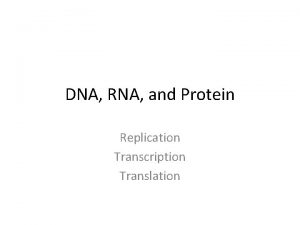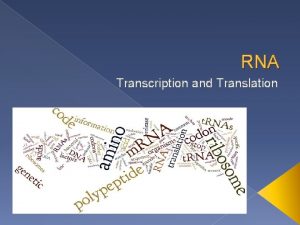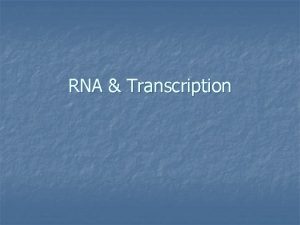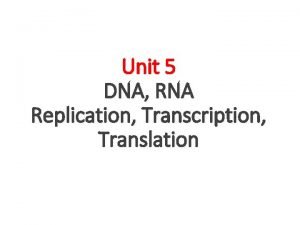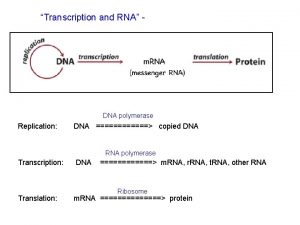DNA and RNA Replication Transcription and Translation Griffiths































































- Slides: 63

DNA and RNA Replication, Transcription and Translation

Griffith’s Experiment

Avery’s Experiment

Hershey-Chase Experiment

A typical Bacteriophage –

Bacteriophage infection cycle

The 3 Key Roles of DNA Storing genetic information. Copying genetic information. Transmitting genetic information.

DNA is 2 long polymers of covalently bonded nucleotides wound around each other and attracted to each other by hydrogen bonds.

The 4 bases are the Purines (adenine and guanine) and the Pyrimidines (Thymine and Cytosine)

Guanine bonds with Cytosine. The three bonds are hydrogen bonds!

Adenine bonds with Thymine. Here there are two hydrogen bonds.

A diagram of DNA

The three components of DNA are the phosphate group, sugar and a nitrogen containing base

Chargaff's rules state that DNA from any cell of all organisms should have a 1: 1 ratio of guanine to cytosine and adenine to thymine.

Rosalind Franklin and her X-Ray diffraction picture of DNA

Watson and Crick – 1953. DNA is 2 chains wound around each other, each chain going in opposite directions. The two chains are held together with hydrogen bonds.

Prokaryote vs. Eukaryote DNA.

Eukaryotic chromosomes contain DNA wrapped around proteins called histones. Each package of 8 histones is called a nucleosome

The strands are complementary in the sense that each strand can be used to make the other half by the sequence of base pairing.

Prokaryote DNA replication

Eukaryotes – DNA replication occurs at many places and proceeds in two directions until each chromosome is copied.

DNA Replication is carried out by a series of enzymes. DNA Polymerase joins individual nucleotides to produce a new DNA molecule

Gene – coded DNA instruction for the production of a protein.

Protein Synthesis an overview http: //www. youtube. com/watch? v=su. N-s. V 0 c. T 6 c

The three main types of RNA

DNA and RNA nucleotides are very similar in structure.

A central tenet of biology describes the two-step process, transcription and translation, by which the information in genes flows into proteins: DNA → RNA → protein.

Because there is no nucleus to separate the processes of transcription and translation, when bacterial genes are transcribed, their transcripts can immediately be translated

Transcription and translation are spatially and temporally separated in eukaryotic cells; that is, transcription occurs in the nucleus to produce a pre-m. RNA molecule

Transcription – the production of RNA molecules from parts of the DNA molecule

Promoters are regions of DNA that tell RNA polymerase where to start. Similar signals tell RNA polymerase to stop

. The pre-m. RNA is processed in the nucleus to remove the introns and splice the exons together into a translatable m. RNA. That m. RNA exits the nucleus and is translated in the cytoplasm.

The steps of pre-m. RNA splicing (intron removal)

The basic building block of a protein is the amino acid.

There are 20 amino acids; each one differs in its R group. Below are four amino acids showing the differences in R groups.

Amino acids are joined together in proteins by peptide bonds.

The language of RNA to the language of protein: The genetic code is a triplet code in which three nucleotides in RNA specify one amino acid in protein.

Translation is the process of decoding an m. RNA message into a polypeptide chain. It all starts with m. RNA

Ribosomes, the organelles on which the m. RNA is translated, consist of two subunits, each of which contains r. RNA and ribosomal proteins.

t. RNA’s bring amino acids to the ribosomes during translation to be assembled into polypeptide chains.

Adding an Amino Acid to t. RNA The correct amino acid is added with the help of an enzyme.

Initiation of Translation

Translation begins when an m. RNA attaches to a ribosome. Each codon is matched by an anticodon with t. RNA. The t. RNA brings in the correct amino acid for that codon.

Elongation of the polypeptide chain begins by the appropriate t. RNA binding to the codon in the A site of the ribosome

At a stop codon, a release factor reads the triplet, and polypeptide synthesis ends

Several ribosomes can translate an m. RNA at the same time, forming what is called a polysome.

http: //www. youtube. com/watch? v=5 i. S 4 CRPPDus

genetics, a mutation is a change of the nucleotide sequence of the genome of an organism, virus, or extrachromosomal genetic element.

A frameshift mutation (also called a framing error or a reading frame shift) is a genetic mutation caused by indels (insertions or deletions) of a number of nucleotides in a DNA sequence that is not divisible by three.

Cystic Fibrosis is an example of a frame shift mutation.

Shaking Vest treatment for Cystic Fibrosis. The vest helps to loosen the thick mucus and allow some of it to be expelled from the lungs.

Chromosomal Mutations This involves changes in the number or structure of chromosomes.

Down syndrome (DS) or Down's syndrome, also known as trisomy 21, is a genetic disorder caused by the presence of all or part of a third copy of chromosome 21.


Polyploidy in Plants. Certain fruits have been developed that have are triploid, (3 N) or tetraploid (4 N). The extra chromosomes cause the fruit to be larger and stronger than the normal 2 N or diploid plant.

Operon An operon is a group of genes that operate together

Lac genes in E. coli. When lactose is not present, the repressor binds to the operator region preventing transcription.

Eukaryotic Gene Regulation The TATA box helps to position RNA polymerase by marking a point just before transcription. Promoters are found just before the TATA box.

Transcription factors – a protein that binds to a specific DNA sequence, controlling the transcription of m. RNA. They can either activate or block RNA polymerase.

RNA interference – small RNA molecules connected to proteins form a Silencing complex. This complex destroys any m. RNA it meets with that has a complementary code.

Hox genes Control the differentiation of cells and tissues in the embryo.

Homeotic genes cause the development of specific structures in plants and animals. i. e. they are involved in determining where , when and how body segments develop in flies.

Pax 6 gene from a mouse inserted onto a fruit fly causes eyes to grow in unusual places.
 Dna replication transcription and translation
Dna replication transcription and translation Bioflix activity dna replication nucleotide pairing
Bioflix activity dna replication nucleotide pairing Chapter 11 dna and genes
Chapter 11 dna and genes Rna
Rna Transcription translation venn diagram
Transcription translation venn diagram Dna to rna transcription
Dna to rna transcription Transcription translation replication
Transcription translation replication Transcription translation replication
Transcription translation replication Replication transcription translation
Replication transcription translation Replication
Replication Transcription and translation coloring
Transcription and translation coloring Dna transcription and translation
Dna transcription and translation Function of dna polymerase 3
Function of dna polymerase 3 Rna transcription
Rna transcription Dna and transcription tutorial
Dna and transcription tutorial Overview of transcription and translation
Overview of transcription and translation Protein synthesis gcse
Protein synthesis gcse Translation protein synthesis
Translation protein synthesis Picture of protein synthesis
Picture of protein synthesis Translation or transcription
Translation or transcription Biology transcription and translation
Biology transcription and translation Transcription and translation practice worksheet answer key
Transcription and translation practice worksheet answer key Dna vs rna
Dna vs rna Transcription
Transcription Dna transcription
Dna transcription Dna transcription
Dna transcription Dna transcription
Dna transcription Dna transcription
Dna transcription Dna transcription
Dna transcription Rna transfer
Rna transfer Translation transcription
Translation transcription Transcription or translation
Transcription or translation Translation transcription
Translation transcription Haploid vs diploid
Haploid vs diploid Multiple choice questions on dna structure and replication
Multiple choice questions on dna structure and replication Dna replication
Dna replication What is the goal of replication
What is the goal of replication Dna and rna coloring worksheet
Dna and rna coloring worksheet Protein synthesis
Protein synthesis Dna and rna
Dna and rna Dna and rna
Dna and rna Dna rna and proteins study guide answers
Dna rna and proteins study guide answers Difference between dna and rna extraction
Difference between dna and rna extraction Dna and rna
Dna and rna Chapter 12 dna and rna
Chapter 12 dna and rna Chapter 12 section 3 dna rna and protein
Chapter 12 section 3 dna rna and protein Dna protein synthesis study guide answers
Dna protein synthesis study guide answers Dna and rna
Dna and rna Nucleotide in rna
Nucleotide in rna Section 12-1 dna
Section 12-1 dna Mrna amino acid chart
Mrna amino acid chart Venn diagram of dna and rna
Venn diagram of dna and rna What is the process called
What is the process called Dehydration synthesis dna
Dehydration synthesis dna 3 componets of dna
3 componets of dna Minor groove
Minor groove Chapter 12 dna and rna section 12-1
Chapter 12 dna and rna section 12-1 Amino acid decoder
Amino acid decoder 3-5 exonuclease vs 5-3 exonuclease
3-5 exonuclease vs 5-3 exonuclease Okazaki fragments
Okazaki fragments Polyribosomes
Polyribosomes Major enzymes in dna replication
Major enzymes in dna replication Accgtat
Accgtat Dna jeopardy
Dna jeopardy



